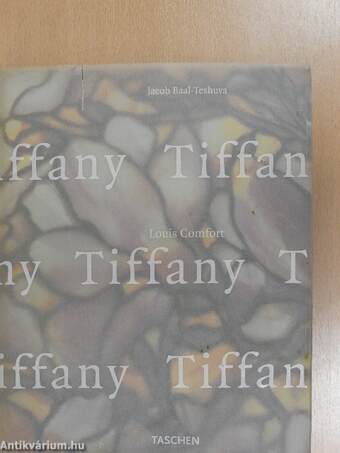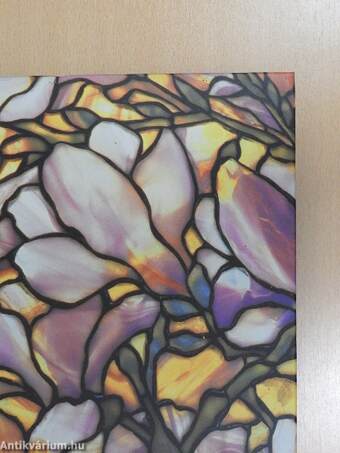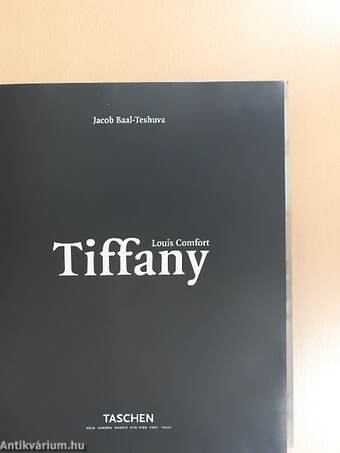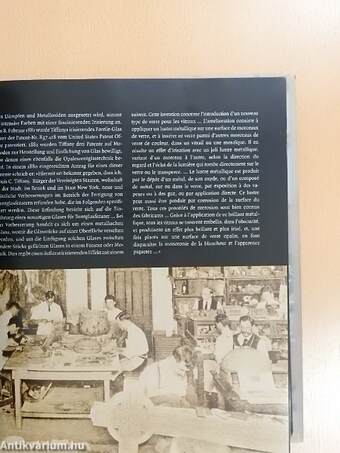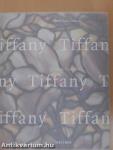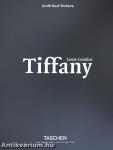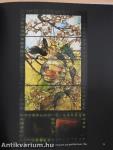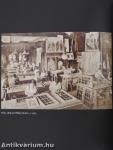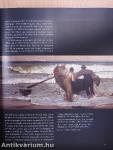1.067.053
kiadvánnyal nyújtjuk Magyarország legnagyobb antikvár könyv-kínálatát

VISSZA
A TETEJÉRE
JAVASLATOKÉszre-
vételek
Louis Comfort Tiffany
| Kiadó: | Taschen GmbH |
|---|---|
| Kiadás helye: | Köln |
| Kiadás éve: | |
| Kötés típusa: | Fűzött kemény papírkötés |
| Oldalszám: | 350 oldal |
| Sorozatcím: | |
| Kötetszám: | |
| Nyelv: | Német Francia Angol |
| Méret: | 22 cm x 18 cm |
| ISBN: | 3-8228-6219-3 |
| Megjegyzés: | Színes és fekete-fehér fotókkal, reprodukciókkal. |
naponta értesítjük a beérkező friss
kiadványokról
naponta értesítjük a beérkező friss
kiadványokról
Fülszöveg
This lavish volume provides an overview of the fifty-year career of Louis Comfort Tiffany (1848-1933)- He is considered one of the most original, versatile, and influential designers, leading U.S. proponent of Art Nouveau, and his works are recognized all over the world.
L.C. Tiffany was the oldest son of Charles Louis Tiffany founder of the prestigious silver and jewelry firm Tiffany in New York City in the 19th century. The son refust : ; father's business, and instead chose to become an artist. While traveling in Europe, and Africa at the age of 20, he was im pressed with the beauty of stained-glass window. ; he sav churches. Returning to the U. S. he experimented with gla and mosaics and developed iridescent glass by exposing it to fumes and metallic oxides, giving it glowing colors. He called it "Favrile" glass, from the old English word "faber", meaning "hand made". His Tiffany Studios produced thousands of windows, lamp shades, vases, mosaics, enamels, jewelry, bronzes,... Tovább
Fülszöveg
This lavish volume provides an overview of the fifty-year career of Louis Comfort Tiffany (1848-1933)- He is considered one of the most original, versatile, and influential designers, leading U.S. proponent of Art Nouveau, and his works are recognized all over the world.
L.C. Tiffany was the oldest son of Charles Louis Tiffany founder of the prestigious silver and jewelry firm Tiffany in New York City in the 19th century. The son refust : ; father's business, and instead chose to become an artist. While traveling in Europe, and Africa at the age of 20, he was im pressed with the beauty of stained-glass window. ; he sav churches. Returning to the U. S. he experimented with gla and mosaics and developed iridescent glass by exposing it to fumes and metallic oxides, giving it glowing colors. He called it "Favrile" glass, from the old English word "faber", meaning "hand made". His Tiffany Studios produced thousands of windows, lamp shades, vases, mosaics, enamels, jewelry, bronzes, and decorating objects. He was also involved in interior design, furniture, rugs, and ceramics. He won many awards and medals after exhibiting in 1900 at the International Exhibition in Paris. His life was "a quest for beauty".
Jacob Baal-Teshuva (born 1929) is an author, critic and freelance curator. He studied at the Hebrew University in Jerusalem and at the New York University. His numerous publications include works on Marc Chagall, Christo and Jeanne-Claude, Alexander Calder, Andy Warhol and Jean Michel Basquiat.
Dieser aufwändige Band bietet einen Überblick über die fünfzigjährige Karriere von Louis Comfort Tiffany (1848-1933), einem der originellsten, vielseitigsten und einflussreichsten Gestalter und führender Vertreter des Jugendstils in den Vereinigten Staaten, der weltweite Anerkennung genoss.
L. C. Tiffany war der älteste Sohn von Charles Louis Tiffany, dem Gründer der renommierten Silber- und Schmuckmanufak-
Vaters mitzuarbeiten, entschloss er sich, Künstler zuivielttenj KTi Alter von zwanzig Jahren bereiste er Europa und Afrika unovvar vor allem von der Schönheit der Ornamentglasfenster in Kirchen beeindruckt. Als er in die Vereinigten Staaten zurückkehrte, experimentierte er mit Glas und Mosaiken und entwickelte mit Hilfe von Dämpfen und Metalloxiden ein schimmerndes Glas in leuchtenden Farben, das er nach dem altenglischen Wort »faber« für handgearbeitet Favrile-Glas nannte. Seine Tiffany Studios stellten Tausende von Fenstern, Lampenschirmen, Vasen, Mosaiken, Emaillen, Schmuckstücken, Bronzen und Dekorationsobjekten her. Aber er beschäftigte sich auch mit Innen-
architektur, Möbeln, Teppichen und Keramik. Nachdem er 1900 an der Weltausstellung in Paris teilgenommen hatte, gewann er jjiele Auszeichnungen und Preise. Sein Leben war ein »Streben nach Schönheit«.
Jjcob Baal-Teshuva (geboren 1929) ist Autor, Kritiker und freier Kurator. Er studierte an der Hebrew University in Jerusalem End an der New York University. Zu seinen zahlreichen Publi-jkationen gehören Arbeiten über Marc Chagall, Christo und jSttnne-Claude, Alexander Calder, Andy Warhol und Jean Michel
fcejtfpjg^ueux volume offre une vue d'ensemble sur cinquante y^qi'arriere de Louis ComfortTifFany (1848-1933), l'un des concepteurs les plus originaux, les plus talentueux et les plus influents de sa génération. Principal propagateur de l'Art Nouveau aux Etats-Unis, il est connu dans le monde entier.
Fils aîné de Charles Louis Tiffany, illustre joaillier et argentier, fondateur de la Tiffany et C° a New York au XIXe siecle, Louis Comfort TifFany refuse de reprendre les affaires de son pere et choisit une carriere artistique. Il visitç l'Europe et l'Afrique et, a l'âge de 20 ans, est impressionné par la beauté des vitraux qui ornent les églises. Rentré aux Etats-Unis, il s'intéresse au verre et aux mosaiques. Il crée un verre irisé qui, par exposition aux vapeurs et aux oxydes métalliques, prend des couleurs rougeoyantes. S'inspirant du vieux mot anglais «faber», fait a la main, il le nomme verre Favrile. Ses ateliers Tiffany vont produire des milliers de panneaux, d'abat-jour, de vases, de mosaiques, d'émaux, de bijoux, de bronzes, et autres objets décoratifs. II s'intéresse également a la décoration intérieure, aux meubles, aux tapis, a la céramique et remporte de nombreuses récompenses et médailles a l'Exposition Internationale de 190b a Paris. Il aura consacré sa vie a « la recherche du beau ».
Jacob Baal-Teshuva (né en 1929) est auteur, critique et conservateur artistique indépendant. Il a étudié a l'université de Jérusalem et a celle de New York. Parmi ses nombreuses publications on trouve des études sur Marc Chagall, Christo et Jeanne-Claude, Alexand|r Calder, Andy Warhol et Jean Michel Basquiat.
COVF.R:
Louis Comfort TifFany, Maanolia floorlamp, c.1903 (detail) Courtesy Minna Rosenblatt Gallery, New York Vissza
Témakörök
- Idegennyelv > Idegennyelvű könyvek > Többnyelvű könyvek
- Művészetek > Művészettörténet általános > Kontinensek művészete > Amerika
- Művészetek > Művészettörténet általános > Idegen nyelv > Egyéb
- Művészetek > Művészettörténet általános > Életrajzok > Egyéb
- Művészetek > Festészet > Korszakok, stílusok > XX. század > Szecesszió
- Művészetek > Festészet > Festészeti technikák > Üvegfestés
- Művészetek > Festészet > Idegen nyelv > Többnyelvű
- Művészetek > Iparművészet > Összefoglalók, tanulmányok > Külföldi
- Művészetek > Iparművészet > Története > Külföldi
- Művészetek > Iparművészet > Formatervezés > Design
- Művészetek > Iparművészet > Idegen nyelv > Többnyelvű
- Művészetek > Iparművészet > Fém-, ötvösművészet > Ékszerek
- Művészetek > Iparművészet > Fém-, ötvösművészet > Edények
- Művészetek > Iparművészet > Bútor, lakberendezés > Bútorkészítés
- Művészetek > Iparművészet > Kerámia, porcelán, üveg > Stílustörténet
- Művészetek > Iparművészet
- Életrajz > Művészet > Egyéb



